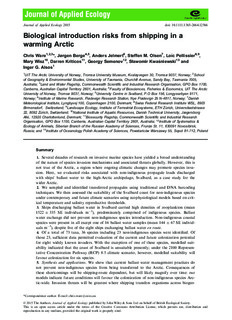| dc.contributor.author | Ware, Christopher | |
| dc.contributor.author | Berge, Jørgen | |
| dc.contributor.author | Jelmert, Anders | |
| dc.contributor.author | Olsen, Steffen M. | |
| dc.contributor.author | Pellisier, Loic | |
| dc.contributor.author | Wisz, Mary S | |
| dc.contributor.author | Kriticos, Darren J. | |
| dc.contributor.author | Semenov, Georgy | |
| dc.contributor.author | Kwasniewski, Sawomir | |
| dc.contributor.author | Alsos, Inger Greve | |
| dc.date.accessioned | 2016-01-11T09:45:12Z | |
| dc.date.accessioned | 2016-02-09T12:58:30Z | |
| dc.date.available | 2016-01-11T09:45:12Z | |
| dc.date.available | 2016-02-09T12:58:30Z | |
| dc.date.issued | 2015-12-14 | |
| dc.identifier.citation | Ware, C., Berge, J., Jelmert, A., Olsen, S. M., Pellissier, L., Wisz, M., Kriticos, D., Semenov, G., Kwaśniewski, S., Alsos, I. G. (2015), Biological introduction risks from shipping in a warming Arctic. Journal of Applied Ecology. doi: 10.1111/1365-2664.12566 | nb_NO |
| dc.identifier.issn | 1365-2664 | |
| dc.identifier.uri | http://hdl.handle.net/11250/2378636 | |
| dc.description | - | nb_NO |
| dc.description.abstract | Several decades of research on invasive marine species have yielded a broad understanding of the nature of species invasion mechanisms and associated threats globally. However, this is not true of the Arctic, a region where ongoing climatic changes may promote species invasion. Here, we evaluated risks associated with non-indigenous propagule loads discharged with ships' ballast water to the high-Arctic archipelago, Svalbard, as a case study for the wider Arctic.
We sampled and identified transferred propagules using traditional and DNA barcoding techniques. We then assessed the suitability of the Svalbard coast for non-indigenous species under contemporary and future climate scenarios using ecophysiological models based on critical temperature and salinity reproductive thresholds.
Ships discharging ballast water in Svalbard carried high densities of zooplankton (mean 1522 ± 335 SE individuals m−3), predominately comprised of indigenous species. Ballast water exchange did not prevent non-indigenous species introduction. Non-indigenous coastal species were present in all except one of 16 ballast water samples (mean 144 ± 67 SE individuals m−3), despite five of the eight ships exchanging ballast water en route.
Of a total of 73 taxa, 36 species including 23 non-indigenous species were identified. Of those 23, sufficient data permitted evaluation of the current and future colonization potential for eight widely known invaders. With the exception of one of these species, modelled suitability indicated that the coast of Svalbard is unsuitable presently; under the 2100 Representative Concentration Pathway (RCP) 8·5 climate scenario, however, modelled suitability will favour colonization for six species.
Synthesis and applications. We show that current ballast water management practices do not prevent non-indigenous species from being transferred to the Arctic. Consequences of these shortcomings will be shipping-route dependent, but will likely magnify over time: our models indicate future conditions will favour the colonization of non-indigenous species Arctic-wide. Invasion threats will be greatest where shipping transfers organisms across biogeographic realms, and for these shipping routes ballast water treatment technologies may be required to prevent impacts. Our results also highlight critical gaps in our understanding of ballast water management efficacy and prioritization. Thereby, our study provides an agenda for research and policy development. | nb_NO |
| dc.language.iso | eng | nb_NO |
| dc.publisher | Wiley | nb_NO |
| dc.rights | Navngivelse 3.0 Norge | * |
| dc.rights.uri | http://creativecommons.org/licenses/by/3.0/no/ | * |
| dc.title | Biological introduction risks from shipping in a warming Arctic | nb_NO |
| dc.type | Journal article | nb_NO |
| dc.type | Peer reviewed | nb_NO |
| dc.date.updated | 2016-01-11T09:45:12Z | |
| dc.source.pagenumber | 10 s. | nb_NO |
| dc.source.journal | Journal of Applied Ecology | nb_NO |
| dc.identifier.doi | 10.1111/1365-2664.12566 | |
| dc.identifier.cristin | 1309652 | |
| dc.relation.project | NFR grant number 195160 | nb_NO |

